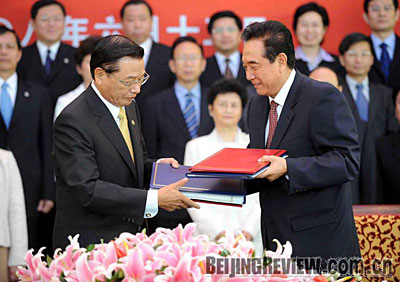| 
A NEW MILESTONE: Representatives from the mainland and Taiwan sign an agreement on June 13, establishing weekend direct charter flights and opening Taiwan tourism to mainland residents in 23 provinces and cities (LI XIAOGUO)
On September 7, Wang Yi, Director of the State Council Taiwan Affairs Office, announced several new measures to promote cross-straits exchanges. Under the new measures, Chinese mainland residents with valid permits to travel to Taiwan can travel via the islands of Kinmen, Matsu and Penghu, as can all residents in the 13 mainland provinces and cities that are open to travel in Taiwan.
Although tourists from the 13 mainland provinces and cities have been able to travel to Taiwan on weekend direct charter flights since July 18, their itineraries are restricted by the fact that they can only board the planes at a limited number of airports and the flights operate only from Friday to Monday.
Traveling to Taiwan via Kinmen, Matsu and Penghu is more flexible and more direct, said Chen Yangbiao, Vice Director of the Tourism Bureau of Fujian Province, at the Roundtable Conference of the Fourth Cross-Straits Travel Fair held in Xiamen City of Fujian on September 7. According to Chen, ships traveling daily between Xiamen and Kinmen depart every 20 minutes, and each trip only lasts 40 minutes, so mainland tourists could choose to leave and return to the mainland on any day. Industry analysts estimate the round-trip cost is about half that of a weekend charter flight.
Although the mainland and Taiwan are separated only by a narrow strip of water, the journey across the straits has been an arduous one. Direct transportation between the two sides was at a complete halt for decades due to political reasons. In 1979, the mainland proposed a "three links" policy that promotes direct mail, trade and transportation services. Progress toward the "three links" had been slow until the turn of the 21st century.
In January 2001, the mainland and Taiwan established direct transportation for the first time since 1949-allowing passengers and cargo to use two routes, namely, Xiamen City-Kinmen and Mawei-Matsu.
The first group of mainland tourists to visit Taiwan since 1949 made the trip from Xiamen to Kinmen in December 2004. The group of 55 people spent three days and two nights in Kinmen only, as they were not allowed to visit other parts of Taiwan.
As of the end of 2007, some 55,906 mainland tourists in 2,558 groups had visited Kinmen, Matsu and Penghu, about half of them in 2007 alone.
The rest of Taiwan, however, was closed to mainland tourists until July 2008. The decision to open Taiwan to mainland tourists came after the mainland-based Association for Relations Across the Taiwan Straits (ARATS) and the Taiwan-based Straits Exchange Foundation (SEF) met in June and signed two agreements, one launching weekend direct charter flights and another permitting mainland tourists to visit Taiwan. The first mainland tour group arrived in Taiwan on July 4, opening a new chapter in cross-straits exchanges.
Tourism administration officials in the mainland and Taiwan are actively discussing more extensive cooperation. At the Roundtable Conference of the Fourth Cross-Straits Travel Fair, the mayors of 23 mainland cities in four provinces closed to Taiwan-including Fujian, Zhejiang, Guangdong and Jiangxi provinces-signed the Xiamen Declaration on forming regional tourism coalitions and strengthening tourism cooperation with Taiwan.
In response, the Transportation and Tourism Bureau in Taiwan's Kinmen County put forth an "N+X" regional cooperation framework plan. The organization explained that N represents the mainland cities in the regional tourism coalition, while X refers to cities in Taiwan. In the first stage, "23+3," 23 mainland cities will begin regional cooperation with Kinmen, Matsu and Penghu in Taiwan. In the second stage, "23+3+2," regional cooperation will be expanded to include Taipei City and Kaohsiung City. The third stage adds 23 counties or cities in Taiwan to make "23+23."
The tourism industries on both sides of the straits should share tourism resources and engage in win-win practices, said Shao Qiwei, head of the National Tourism Administration of China, at the opening ceremony of the Cross-Straits Travel Fair. The tourism industries would not only build a cross-straits tourism brand, Shao said, but also a tourism economic rim.
Relevant tourism departments and enterprises in Fujian have been working with their counterparts in Taiwan on plans for further tourism development. Travel agencies have worked together to produce various travel itineraries. In addition to designing and marketing tourism products, the two sides have been weaving a land, water and air transportation network. | 